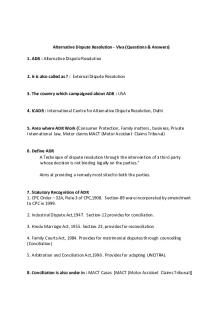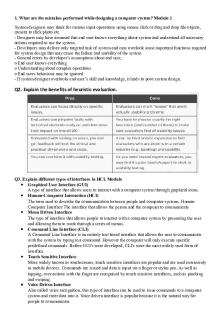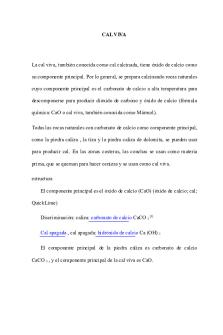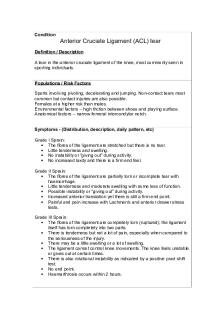Viva knee movements PDF

| Title | Viva knee movements |
|---|---|
| Course | Human Movement: Anatomy & Examination |
| Institution | Glasgow Caledonian University |
| Pages | 2 |
| File Size | 36.9 KB |
| File Type | |
| Total Downloads | 23 |
| Total Views | 141 |
Summary
VIVA PLANS...
Description
Viva - Anterior Knee Movements Introduction - name, consent, hand hygiene, bed hight, brakes on plinth, ask which leg is sore Active physiological movements with goniometry - FEML Passive physiological movements - FEML Joint Test/Accessory movements - AP,PA (sit on foot) , lateral/medial translations, patellar femoral movements Introduction - Important to introduce myself, ask for consent then apply hand hygiene so patient feels at ease - I will communicate well with my patient by talking slowly whilst using clear and simple language. I will be aware of health and safety issues by checking the bed height and brakes before starting Active physiological movements with goniometry:
- An active movement is when the patient does the movement without assistance. - I will measure range of movement with the goniometry which is a piece of equipment physiotherapists use to accurately measure joint angles. It is an accurate apparatus, however human error can occur so the therapist needs to be careful. - I will be focusing on the patient and therapist positioning when taking my readings and I am going to read out each number Flexion - patient sitting up legs out, then bring heel to glutes with foot on the bed. Extension - patient sitting up, knee fully extended with toes pointing up. Then get patient to put their knee into the plinth as far as possible Medial and lateral rotation - patient sitting at end of bed and put goniometry under foot then measure With goniometry always line it up with a boney landmark and then measure Passive physiological movements:
- Passive movement is when the physiotherapist takes control and performs the movement on the patient while they relax
- Same as active, as I want to do a comprehensive examination of the knee so I am going to do all movements - I will also be examining the end feel. The types of end-feel include capsular, boneon-bone, spasm, springy block and many more. The most common type of end feel in the body is a firm end feel, which is caused by tension in soft tissues - End feel is a sensation transmitted to therapists hand when carrying out an assessment which indicates what is limiting the movement. Accessory movements Joint Integrity test specifically shows how intact the joints are Accessory movement is when the physiotherapist does the movement because the patient cant perform it themselves Accessory movements of patella femoral (patella tap/patella sweep) PA – testing posterior cruciate ligament. - Sit on patients foot to support. Palpate joint line, rest thumbs over it. Push the tibia in an explosive movement. AP – testing anterior cruciate ligament - Sit on patients foot to support. Palpate joint line, rest thumbs over it. Pull the tibia in an explosive movement....
Similar Free PDFs

Viva knee movements
- 2 Pages

2017-rehab knee - knee exercises
- 8 Pages

ADR Viva QS - ADR VIVA
- 7 Pages

Knee Orthopedic Tests
- 47 Pages

HMI VIVA - HMI Viva Peparation
- 9 Pages

Cardinal Movements
- 1 Pages

The Knee - Professor Scibek
- 7 Pages

CAL VIVA - Resumen sobre cal viva
- 14 Pages

KNEE-ACL-tear
- 3 Pages

The Knee and Thigh
- 10 Pages

Types of Body Movements
- 2 Pages

Accessory Movements 1
- 4 Pages

VIVA Notes
- 30 Pages

VIVA preparation
- 2 Pages

Java viva
- 13 Pages

Python viva
- 4 Pages
Popular Institutions
- Tinajero National High School - Annex
- Politeknik Caltex Riau
- Yokohama City University
- SGT University
- University of Al-Qadisiyah
- Divine Word College of Vigan
- Techniek College Rotterdam
- Universidade de Santiago
- Universiti Teknologi MARA Cawangan Johor Kampus Pasir Gudang
- Poltekkes Kemenkes Yogyakarta
- Baguio City National High School
- Colegio san marcos
- preparatoria uno
- Centro de Bachillerato Tecnológico Industrial y de Servicios No. 107
- Dalian Maritime University
- Quang Trung Secondary School
- Colegio Tecnológico en Informática
- Corporación Regional de Educación Superior
- Grupo CEDVA
- Dar Al Uloom University
- Centro de Estudios Preuniversitarios de la Universidad Nacional de Ingeniería
- 上智大学
- Aakash International School, Nuna Majara
- San Felipe Neri Catholic School
- Kang Chiao International School - New Taipei City
- Misamis Occidental National High School
- Institución Educativa Escuela Normal Juan Ladrilleros
- Kolehiyo ng Pantukan
- Batanes State College
- Instituto Continental
- Sekolah Menengah Kejuruan Kesehatan Kaltara (Tarakan)
- Colegio de La Inmaculada Concepcion - Cebu